Candle Heated Teapots

Many live according to Bender's principle - “they don’t make a cult out of food”. And it is difficult to convince a person who is used to brewing tea in a bag in a minute that instead of a quick cup on the run, you can enjoy a truly well-brewed drink in a beautiful dish. And does anyone need to prove this, if there are enough lovers of beautiful tea parties. And they probably have a candle-heated teapot. And if not yet, it makes sense to take a closer look at a useful acquisition.


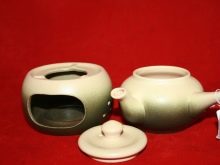
A bit of history
Teapots appeared a long time ago: in China, in the 14th century, according to artifacts, an object arose that is still associated with tea drinking. Before the invention of the teapot, cups were used, and a noble drink was brewed in them. The leaves were kneaded, thrown into a cup and poured with boiling water.
Outwardly, the first teapots for brewing did not look anything special: small vessels of red clay, however, capable of allowing air to pass through. But the device itself was expensive, because the longer the liquid is inside, the richer the taste of the tea. Teapots appeared in Europe only 3 centuries later.
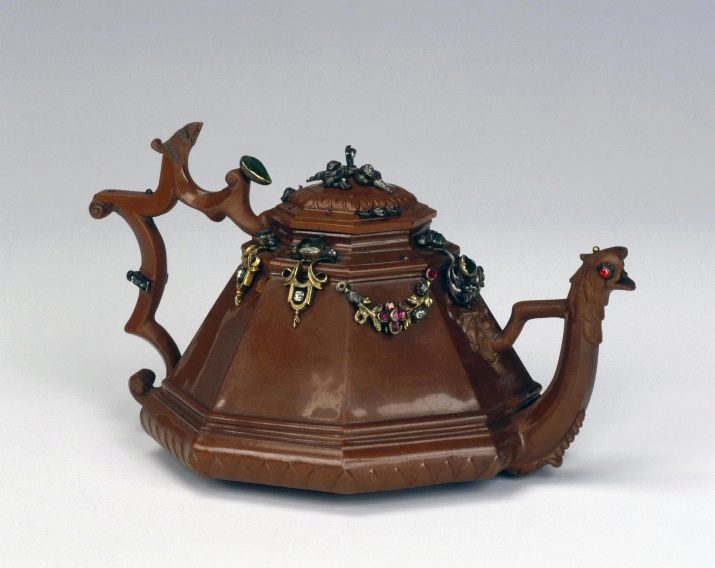
Even then, there were teapots with a stand, but they were not of great value.
And only when porcelain goods or teapots made of glass began to be imported from China, they significantly increased in price.
Heated kettle device
In the device itself, there is no special trick: in appearance, a teapot with a tea candle can resemble an aroma lamp. The candle will heat the air inside the container, it will prevent the liquid from cooling. And this is where the functions of the candle end: it only allows you to maintain the temperature, but not to increase it, not to warm up the contents of the teapot.
Although no, there is another function of such a device - an aesthetic one. Glass teapot with a candle looks romantic and sophisticated, and if you want to turn a standard tea party into a sincere conversation or relaxation, such teapots are an excellent tool.

During the heating process, the flame cannot touch the bottom of the dishes, otherwise it will negatively affect the taste of the tea, the kettle will quickly fail.
And if the material is not yet heat-resistant, you can say goodbye to the kettle. Therefore, manufacturers make deep and high stands with special candles at the bottom.
Used for heating candles in sleeves, they are called tea. You can buy the simplest, cheapest candles, or you can find colored candles, sparkling candles, scented candles. It all depends on how you see the process of tea drinking, what flavors you like. Experimenting helps you find the best option.


Choosing a tea set
When buying a heated teapot it is difficult to immediately decide which set to buy: you can buy a transparent glass teapot, or you can buy a ceramic one with an interesting pattern.
Specifications
- Glass ones attract with their transparency. The light, seemingly weightless material allows the tea drinker to admire the processes taking place in the container: the play of color and light, the flow of tea leaves and various fillings - this is still a pleasure for an esthete. For the manufacture of such teapots, heat-resistant glass is used, and if the glass is tempered, then even temperature drops are not afraid of it.

- Ceramic teapots are distinguished by high-quality, uniform heating. The most attractive in this group are porcelain teapots - they are the lightest and most elegant. The ceramics will be coarser, but, for example, in the interior of country and Provence, it is the ceramics that will be organic. Faience makes the product more fragile, but it looks beautiful.

- Cast iron teapots. They are the heaviest, but also the most heat-absorbing. Even without heating, they can maintain the temperature for a long time. But if you have a stand, the kettle won't cool down for two hours. A very convenient option for lovers of long tea drinking.

All options are worthy of consideration, it is difficult to deny aesthetics to at least one of them. It all depends on which kitchen the kettle will go to, in which interior it will "live".
What should be the stand?
Material matching is optional. But external compatibility and size compatibility are a must. Finally, it is important that the kettle and base are thermally compatible. Typically, heat-resistant glass heaters are included with a glass kettle. And this is convenient: the transparent stand does not interfere with the view, through it you can see the candle itself and its flame. But the stand must be reinforced with a metal insert - this will improve the safety and durability of the device.
In addition, the glass teapot can be combined with ceramic and stainless steel base bases.

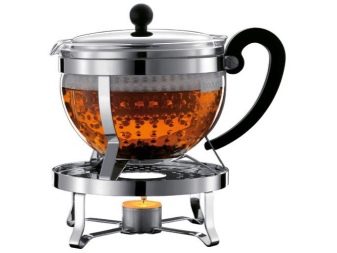
Looks very nice with a ceramic filter strainer heater inside a glass teapot. Wood and steel will also be an interesting combination. But cast iron and glass are practically incomparable, therefore there are no such combinations. Only cast iron is suitable for cast iron. By the way, such teapots are often not designed strictly for a candle, but also for hot coal.
Stand options
- Spherical bowl. At the top, the container will be closed with a lid with holes. There may also be a wide neck in the bottom parameters. If the model is made of cast iron, it is low, while the glass and porcelain stands are higher.
- A heart with a place for a candle in the middle. This option is good for everyone, but you cannot replace the candle without first removing the kettle from the stand. But ideally, replacing a candle cannot violate the integrity of the structure for a minute.
If you like practical models in a minimalistic solution, choose the stainless steel stand option.


They are usually adapted to different bottom sizes.Very interesting models of coasters from the cast-iron series: they are stylized as retro, they look like heirloom household values.
Models in patina and copper are authentic and self-sufficient, they will not go out of fashion for a long time.
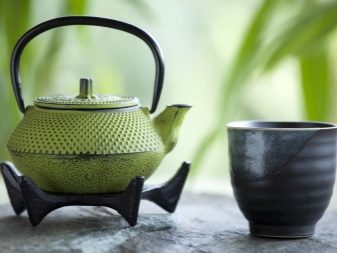

Tea drinking and etiquette
To purchase a kettle with a spectacular heating stand is not yet a beautiful procedure for drinking tea. What is important is the presentation, which really raises the appetite, sets you up for conversation and relaxation. The differences between a teapot with a candle holder and a traditional teapot are not so great that etiquette describes this point in a special way.
Tea drinking rules:
- the cup is held only by the ear, you do not need to insert your finger into the ear;
- the stirring spoon is placed on the saucer or rests on its edge;
- any decor for tea drinking (children are sometimes served with straws and umbrellas even for tea), the guest can keep;
- they do not drink tea from a spoon, it is needed only for stirring sugar;
- blowing tea in public is not worth it - while the drink cools down, you can just chat with the guests.
As for teapots with a stand, it makes sense to light a candle already at the table.
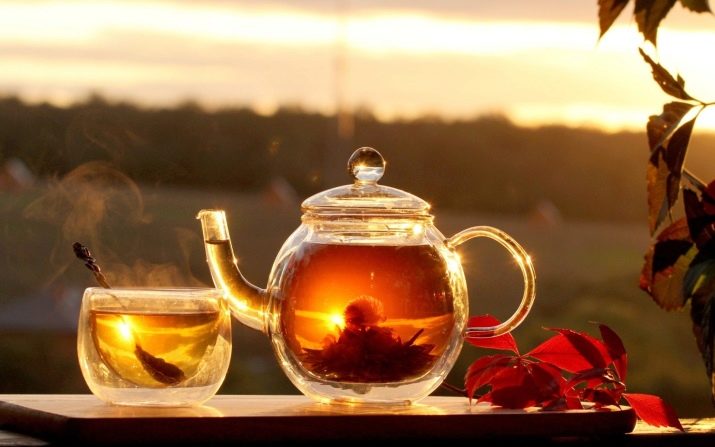
While you are carrying the kettle, it can go out, slip out, etc. Keep a couple of shell candles in stock in case the tea party drags on and you have to change the heating.
If you make your own tea or make tea hot lemonade, then a teapot with a candle is ideal for serving. Behind the glass walls, berries and slices of citrus fruits, herbs and spices will circle. Brewing itself becomes a small creative act that is pleasant to see for guests as well. A good option for the case when guests are on the doorstep (and unexpectedly), and you manage to quickly organize only a tea party.
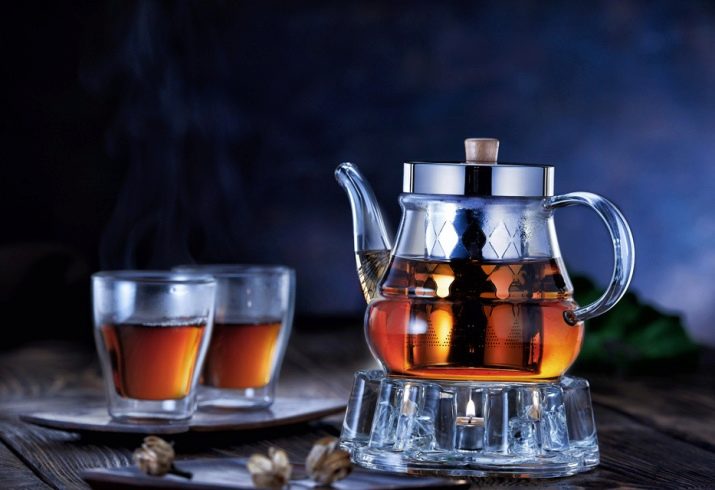
Take basic black or green tea, add to it two or three slices of orange, a circle of lemon, raspberries and halves of strawberries, currant or mint leaves. And serve all this brewed beauty to the table: in a glass teapot, which will be heated in a special stand with an aromatic (or ordinary) candle. Guests will be delighted with such a presentation and will want to quickly taste the picturesque drink, and you can be proud that even spontaneous visitors will not catch you by surprise.

For a small overview of the candle-heated teapot, see below.








